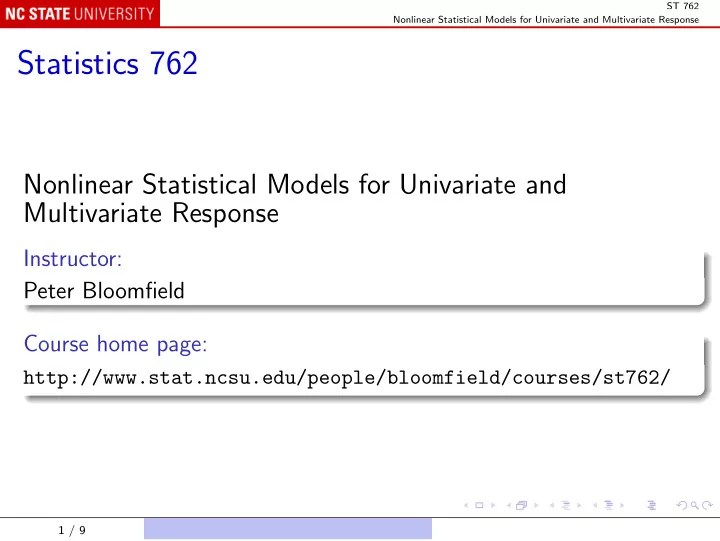

ST 762 Nonlinear Statistical Models for Univariate and Multivariate Response Statistics 762 Nonlinear Statistical Models for Univariate and Multivariate Response Instructor: Peter Bloomfield Course home page: http://www.stat.ncsu.edu/people/bloomfield/courses/st762/ 1 / 9
ST 762 Nonlinear Statistical Models for Univariate and Multivariate Response Introduction Objective: provide a comprehensive treatment of modern approaches to modeling univariate and multivariate responses. Theme: univariate and multivariate models share common features; univariate models will be covered first, in detail; multivariate models will then be discussed. 2 / 9
ST 762 Nonlinear Statistical Models for Univariate and Multivariate Response Point of departure: “Classical” linear regression Y = response , or dependent variable (scalar) x = ( p × 1) covariate , or independent variable . 3 / 9
ST 762 Nonlinear Statistical Models for Univariate and Multivariate Response Covariates may be controlled (fixed) or merely observed (random), but in either case are known without error . The response Y is always viewed as random, because: it may have measurement error ; it may vary from one subject to another; since subjects are sampled randomly from some population, this is also a source of randomness; it may vary randomly over time for a given subject. 4 / 9
ST 762 Nonlinear Statistical Models for Univariate and Multivariate Response A regression model is a specification of the distribution of Y for each possible value of x . If x is fixed, this is just the distribution of Y as a function of x . If x is random, x and Y have a joint distribution, and the regression model is the conditional distribution of Y given x . In the random x case, a complete probability model requires also the marginal distribution of x , but that is irrelevant to the dependence of Y on x . 5 / 9
ST 762 Nonlinear Statistical Models for Univariate and Multivariate Response Observed data are pairs ( Y j , x j ), j = 1 , 2 , . . . , n . Matrix notation: x T 1 x T 2 Y = ( Y 1 , Y 2 , . . . , Y n ) T , X = . . . x T n where Y is ( n × 1) and X is ( n × p ). 6 / 9
ST 762 Nonlinear Statistical Models for Univariate and Multivariate Response The linear regression model: Y j = x T j β + e j , j = 1 , 2 , . . . , n . In matrix notation, Y = X β + e where e = ( e 1 , e 2 , . . . , e n ) T . 7 / 9
ST 762 Nonlinear Statistical Models for Univariate and Multivariate Response Assumptions: (0) E( e j ) = 0; no bias. (1) E( Y j | x j ) = x T j β ; implies (0). (2) e 1 , e 2 , . . . , e n are identically distributed, with variance σ 2 . (3) e 1 , e 2 , . . . , e n are independent. (4) e 1 , e 2 , . . . , e n are normally distributed. 8 / 9
ST 762 Nonlinear Statistical Models for Univariate and Multivariate Response In the random covariate case, (2) – (4) are interpreted conditionally on X . Under (1) – (4), X β , σ 2 I n � � Y ∼ N . All the standard statistical theory of estimation and testing may be derived from this property. 9 / 9
Recommend
More recommend